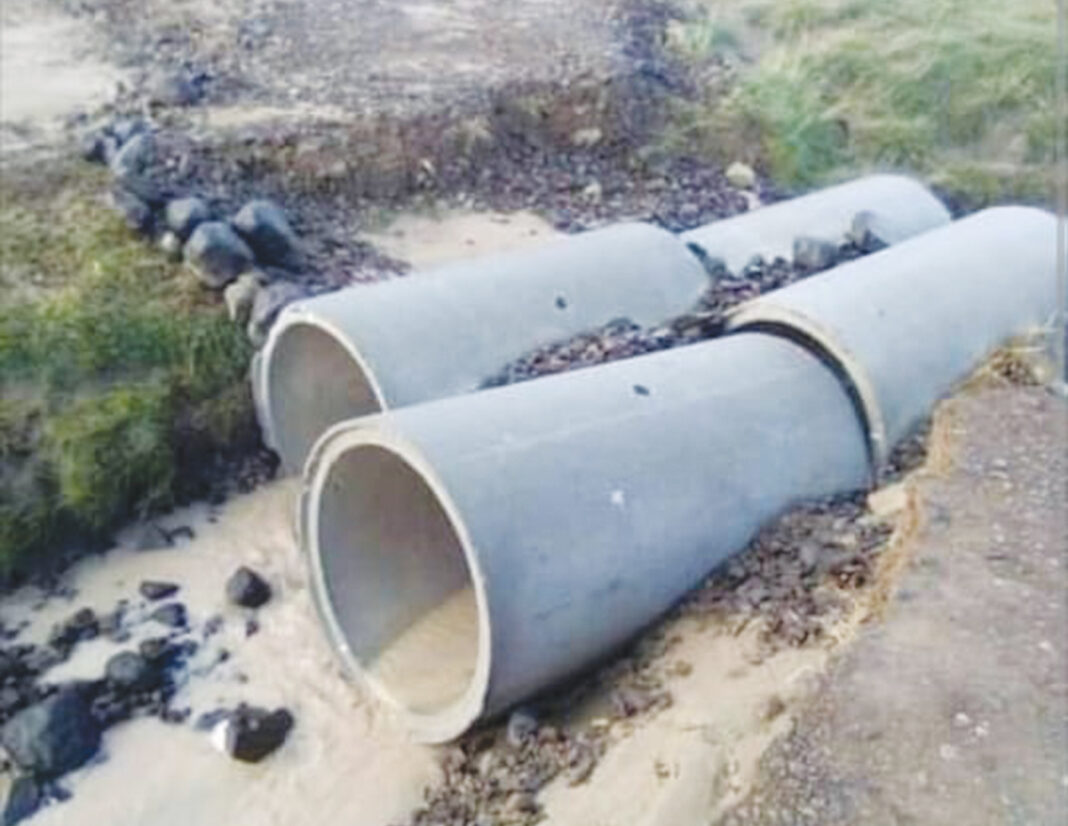By ‘Majirata Latela
Controversy ensues as a bridge is constructed in two days only to be destroyed by heavy rains one week later. A local civil engineer says the structure does not even qualify to be called a bridge, and it is characterised by sloppiness.
The Prime Minister Dr Moeketsi Majoro is expected to declare a state of emergency in the wake of the large scale destruction to public and private properties caused by the recent heavy rainfalls that left roads, bridges and houses eroded.
The heavy rains, according to the Lesotho Meteorological Services, were not related to last week’s Tropical Cyclone Eloise which battered some of the SADC countries like Mozambique, Swaziland, Zimbabwe and Botswana.
However, they have been pounding the country and wreaking havoc from Wednesday last week to Friday. On Thursday, news started trickling in of people, bridges, roads, houses, farms and animals that were washed away by the floods, and this week the downpours showed no signs of abating anytime soon.
Speaking to theReporter on Wednesday this week, the minister of local government and chieftainship, Tṧoinyana Rapapa, disclosed that the Prime Minister will declare a state of emergency on Monday, after cabinet has received details of all the damage that has been caused by the floods.
“My ministry yesterday sent a circular to all councillors and District Administration Offices to hold meetings on Thursday and Friday to compile a full report of the damage caused by the heavy rains.
“The list will include details of all the people who are said to have drowned during the floods, houses and buildings that have collapsed due to the rains, fields, livestock, roads and bridges that have been destroyed.
“After receiving the dossier which is supposed to be on my desk by Monday and the state of emergency has been declared, we will then be in a position to estimate the cost of the damage. At the moment, we do not yet know the full extent and cost of all the damage,” Rapapa said.
He further disclosed that they have decided that to fix some of the roads, especially those that are in the villages (gravel roads), they will use the labour-intensive labour strategy commonly knowns as Fato- Fato. He, however, indicated that they will also need people of goodwill to help with any resources they have to get the roads fixed.
He gave an assurance that all equipment used for construction of roads and bridges that his ministry and the ministry of public works have will be out there getting the work done, from Monday.
“We will start by repairing bridges and roads that are easy to fix, prioritising those roads and bridges on which people desperately depend. The lists I am expecting will determine where we need to start,” he explained.
For her part, the Disaster Management Authority deputy chief executive, Caroline Mahosi, said stakeholders in the matter have met to explore possible solutions to the problem that the country is faced with, while making sure that they do not shift their focus from theCovid-19 pandemic.
The stakeholders, she said, include line ministries, non-governmental organisations and Lesotho’s economic partners, who will all work together to make sure that the destruction is fixed as a matter of urgency.
“We urgently need to get a rapid assessment report and if it weren’t for the ongoing rains, we would be out there from today to make sure that the report is complete at least by Friday, so that on Monday we prepare for construction.
“As of now, DMA only has M4million which was set aside for disasters like this, but if what we are seeing and hearing is anything to go by, then it is clear we will need to ask for more money from the ministry of finance.
“The damage seems to be huge, that is why we are involving all stakeholders in this matter; however, we will have a clear roadmap from Monday,” Mahosi said.
Meanwhile, the ministry of public works recently released a statement indicating that M5million from the Contingency Fund of the Government and the Road Fund Budget has been allocated to the ministry to repair damaged roads.
The statement showed that emergency works to repair various road sections damaged by these ongoing heavy rains had commenced and that includes, removal of landslides, rock falls and debris to open roadways, erosion protection works, pothole repairs and patching, culvert repairs and reinstatement, restoration of washed away embankments, protection of eroded road sections as well as unclogging of drainage structures.
“The road sections where works have been completed include Liphiring collapsed minibridge diversion, Matelile landslide removal, Makhalaneng debris removal.
“The following areas’ emergency rectifications have commenced: – the A1 Road near Marakabei Lodge, Matlameng to Nkoeng, A8 Road between Pitseng and Katse, Marabeng, Tsereoane, Ramapepe, A3 Road between Masianokeng up to Mantšonyane, A5 Road between Roma to Semonkong, A4 Road between Quthing and Mount Moorosi, and B501 Road between Nyakosoba and Mofoqohi to name a few,” the statement reads.
To find out if the allocated budget will be enough to fix all damages, the paper tried to talk to the minister of public works and his principal secretary, but neither was available for comment.
Meanwhile, the destruction has also exposed serious sloppiness in the construction of vital infrastructure, which has raised suspicion of malpractices in public procurement.
An example is one bridge in the Qhalasi constituency on Mohale’s Hoek, which is alleged to have been built in two days – at a rumoured cost of between M1.3million and M1.5million – only to give in a week later to the heavy rains.
Pictures of the bridge before and after construction have gone viral, and according to a local civil engineer who did not want to be named, it appears to be a mere two-barrel culvert which does not have a head wall and two wind walls.
He said the main purpose of the wind wall is to hold the backfill from sliding to the entrance and protect the soil from eroding. It usually casts soil pressure and directs the stream into the culvert.
“Also, there had to be a drainage culvert outlet headwall which helps the surrounding area, to lessen the possibility of flooding. In a proper bridge, headwalls also help to prevent erosion around bridges to protect structural integrity. The inlet structures help to guide the water into the circular part of the pipe; the inlet and outlet structures are the concrete that is cast and shaped around the pipe to avoid water eroding the road above the pipe.
“Looking at the photo of that bridge, it does not look like there was adequate compaction between the pipes and above as I can see gaps and large stones which are so oversized they definitely could not have compacted sufficiently, which will lead to easy erosion. Clogged pipes as seen in the photo mean the pipe was half-filled with gravel, which lowered the amount of water the pipe could carry during the rainy season, hence adding to a restricted flow, which invites flood. This bridge or works should have working drawings which mostly guide the contractor, – if not the standard – design standards for roads and bridges of the department of transport should be used
“I do not see how the pipes were joined or the materials that joined them; there is normally a rubber ring which ensures no water seeps between the joined pipes so that erosion does not occur. Also the holes used for lifting the pipe were not filled with grout such that the soil does not cave into the pipe or the small fines slowly get drawn in. The pipes do not seem to be in line with the next, which could suggest that they were installed not aligned, or the ground underneath (bedding) was not well compacted, thereby causing the shift of pipes,” the engineer explained.
The minister of public works and his principal secretary could not be found to comment on the ministry’s role in the construction of this bridge, as their phones rang unanswered.









